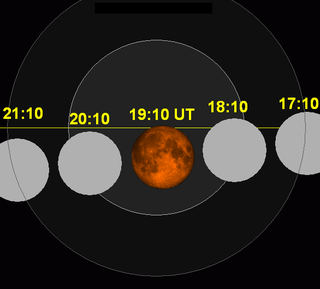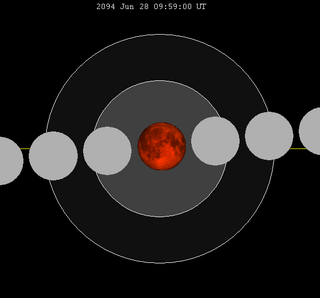
A partial lunar eclipse took place on Sunday, August 15, 1943. The Moon was strikingly shadowed in this deep partial eclipse which lasted 2 hours and 58 minutes, with 87% of the Moon in darkness at maximum.

A partial lunar eclipse took place on Sunday, August 15, 1943. The Moon was strikingly shadowed in this deep partial eclipse which lasted 2 hours and 58 minutes, with 87% of the Moon in darkness at maximum.
| Ascending node | Descending node | |||||
|---|---|---|---|---|---|---|
| Saros | Date Viewing | Type Chart | Saros | Date Viewing | Type Chart | |
| 102 | 1940 Mar 23  | Penumbral | 107 | |||
| 112 | 1941 Mar 13  | Partial | 117 | 1941 Sep 05  | Partial | |
| 122 | 1942 Mar 03  | Total | 127 | 1942 Aug 26  | Total | |
| 132 | 1943 Feb 20  | Partial | 137 | 1943 Aug 15  | Partial | |
| 142 | 1944 Feb 09  | Penumbral | 147 | 1944 Aug 04  | Penumbral | |
It is part of Saros series 137.

A total lunar eclipse took place on 15 June 2011. It was the first of two such eclipses in 2011. The second occurred on 10 December 2011. While the visual effect of a total eclipse is variable, the Moon may have been stained a deep orange or red colour at maximum eclipse.

A total lunar eclipse took place at the Moon's descending node of the orbit on Tuesday, September 16, 1997, the second of two lunar eclipses in 1997. A shallow total eclipse saw the Moon in relative darkness for 1 hour, 1 minute and 30.8 seconds. The Moon was 19.094% of its diameter into the Earth's umbral shadow, and should have been significantly darkened. The partial eclipse lasted for 3 hours, 16 minutes and 28.2 seconds in total. The penumbral eclipse lasted for 5 hours, 8 minutes and 20.1 seconds. The partial eclipse lasted for 3 hours, 16 minutes and 28.2 seconds. The total eclipse lasted for 1 hour, 1 minute and 30.8 seconds. Maximum eclipse was at 18:46:39.1 UTC. The moon's apparent diameter was extremely large because occurred only 3 hours and 21 minutes past perigee. The Moon was only 356,986 km of the Earth at greatest eclipse.

A total lunar eclipse will take place between Monday and Tuesday, June 25-26, 2029. A central total eclipse lasting 1 hour and 41 minutes 53 seconds will plunge the full Moon into deep darkness, as it passes right through the centre of the Earth's umbral shadow. While the visual effect of a total eclipse is variable, the Moon may be stained a deep orange or red color at maximum eclipse. It will be able to be seen from most of the Americas, Western Europe and Africa. The partial eclipse will last for 3 hours and 39 minutes 32 seconds in total.

A total lunar eclipse occurred on 15–16 May 2022, the first of two total lunar eclipses in 2022. The event occurred near lunar perigee; as a result, this event was referred to some in media coverage as a "super flower blood moon" and elsewhere as a "super blood moon", a supermoon that coincides with a total lunar eclipse. This was the longest total lunar eclipse visible from nearly all of North America since August 17, 1989 until the next eclipse on November 8.

A total lunar eclipse took place on Friday, June 4, 1993, the first of two total lunar eclipses in 1993, the second being on Monday, November 29. The Moon was plunged into darkness for 1 hour and 36 minutes, in a deep total eclipse which saw the Moon 56% of its diameter inside the Earth's umbral shadow. The visual effect of this depends on the state of the Earth's atmosphere, but the Moon may have been stained a deep red colour. The partial eclipse lasted for 3 hours and 38 minutes in total. The moon passed through the center of the Earth's shadow.

A total lunar eclipse will take place on July 7, 2047. It will last 1 hour 40 minutes and 49 seconds and will plunge the full Moon into deep darkness, as it passes right through the centre of the Earth's umbral shadow. While the visual effect of a total eclipse is variable, the Moon may be stained a deep orange or red colour at maximum eclipse. This will be a great spectacle for everyone who sees it. The partial eclipse will last for 3 hours and 39 minutes in total.
A total lunar eclipse took place on Saturday, May 24 and Sunday, May 25, 1975, the first of two total lunar eclipses in 1975. The Moon was plunged into darkness for 1 hour and 28 minutes in a deep total eclipse which saw the Moon 43% of its diameter inside the Earth's umbral shadow. The visual effect of an eclipse depends on the state of the Earth's atmosphere, but the Moon may have been stained a deep red colour. The partial eclipse lasted for 3 hours and 35 minutes in total. Occurring only 4.4 days after perigee, the Moon's apparent diameter was 0.7% larger than average. The moon was 377,010 km from the Earth at greatest eclipse.

A total lunar eclipse will take place on October 19, 2051. The northern limb of the moon will pass through the center of the Earth's shadow.
A total lunar eclipse took place on Thursday, April 24, 1986, the first of two total lunar eclipses in 1986, the second being on October 17, 1986. The Moon was plunged into darkness for 1 hour, 3 minutes and 34.8 seconds, in a deep total eclipse which saw the Moon 20.217% of its diameter inside the Earth's umbral shadow. The visual effect of this depends on the state of the Earth's atmosphere, but the Moon may have been stained a deep red colour. The partial eclipse lasted for 3 hours, 18 minutes and 46.8 seconds in total. The Moon was just 1.2 days before perigee, making it 5.3% larger than average.
A total lunar eclipse took place on Thursday, September 6, 1979, the second of two lunar eclipses in 1979. A shallow total eclipse saw the Moon in relative darkness for 44 minutes and 24.7 seconds. The Moon was 9.358% of its diameter into the Earth's umbral shadow, and should have been significantly darkened. The partial eclipse lasted for 3 hours, 11 minutes and 54.1 seconds in total.

A total lunar eclipse took place on Monday, May 13, 1957, the third of fourteen total lunar eclipses of Lunar Saros 130. The Moon was plunged into darkness for 1 hour and 18 minutes, in a deep total eclipse which saw the Moon 30% of its diameter inside the Earth's umbral shadow. The visual effect of this depends on the state of the Earth's atmosphere, but the Moon may have been stained a deep red colour. The partial eclipse lasted for 3 hours and 32 minutes in total.

A total lunar eclipse took place on Wednesday, May 3, 1939. A shallow total eclipse saw the Moon in relative darkness for 1 hour and 2 minutes. The Moon was 18% of its diameter into the Earth's umbral shadow, and should have been significantly darkened. The partial eclipse lasted for 3 hours and 27 minutes in total.
A total lunar eclipse took place on Friday, April 22, 1921. This was the first total lunar eclipse of Saros cycle 130. A shallow total eclipse saw the Moon in relative darkness for 40 minutes and 6 seconds. The Moon was approximately 7% of its diameter into the Earth's umbral shadow, and should have been significantly darkened. The partial eclipse lasted for 3 hours and 22 minutes in total.
A partial lunar eclipse took place on Sunday, April 12, 1903. This nearly total lunar eclipse of Saros cycle 130 preceded the first total eclipse on April 22, 1921. The Moon was almost covered by the Earth's shadow in a very deep partial eclipse, which lasted 3 hours and 17 minutes. With 96.77% of the Moon in shadow at maximum eclipse, this was quite a memorable event.

A total lunar eclipse will take place on July 29, 2083. The Moon will be plunged into darkness for 1 hour and 30 minutes, in a deep total eclipse which will see the Moon 48.3% of its diameter inside the Earth's umbral shadow. The visual effect of this depends on the state of the Earth's atmosphere, but the Moon may be stained a deep red colour. The partial eclipse will last for 3 hours and 33 minutes in total.

A total lunar eclipse will take place on July 17, 2065. A dramatic total eclipse lasting 1 hour and 37 minutes will plunge the full Moon into deep darkness, as it passes right through the centre of the Earth's umbral shadow. While the visual effect of a total eclipse is variable, the Moon may be stained a deep orange or red colour at maximum eclipse. This will be a great spectacle for everyone who sees it. The partial eclipse will last for 3 hours and 36 minutes in total. The moon will pass through the center of the Earth's shadow.

A total lunar eclipse will take place on June 28, 2094. The moon will pass through the center of the Earth's shadow. While the visual effect of a total eclipse is variable, the Moon may be stained a deep orange or red color at maximum eclipse. With a gamma value of only 0.0288 and an umbral eclipse magnitude of 1.8234, this is the greatest eclipse in Saros series 131 as well as the second largest and darkest lunar eclipse of the 21st century.

A partial lunar eclipse took place on Saturday, August 26, 1961, the second of two partial lunar eclipses in 1961. This nearly total lunar eclipse of Saros cycle 137 preceded the first total eclipse on September 6, 1979. It took place around lunar perigee, therefore as a result, the Moon appeared larger than usual. It was the largest partial lunar eclipse since October 28, 1939, making it the second largest partial lunar eclipse of the 20th century.

Saros cycle series 133 for solar eclipses occurs at the Moon's ascending node, repeating every 18 years, 11 days, containing 72 events. All eclipses in this series occurs at the Moon's ascending node.

Saros cycle series 130 for lunar eclipses occurs at the moon's ascending node, repeats every 18 years 11+1/3 days. The 130th lunar saros is associated with Solar Saros 137.